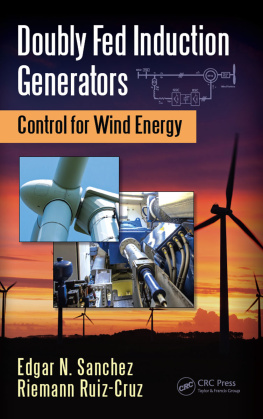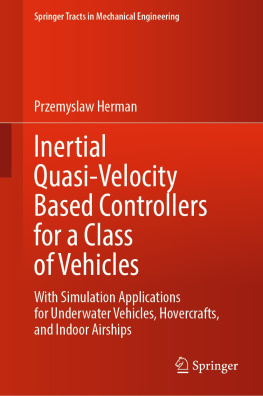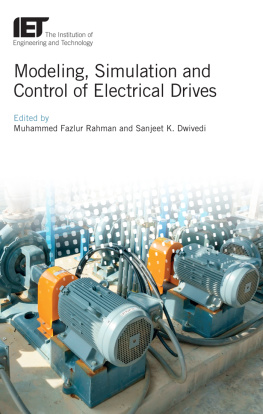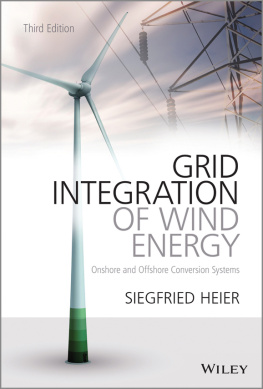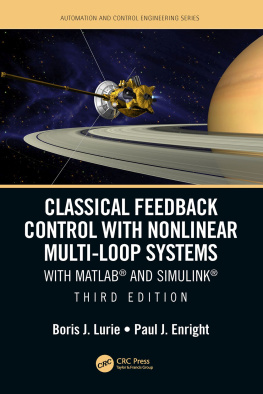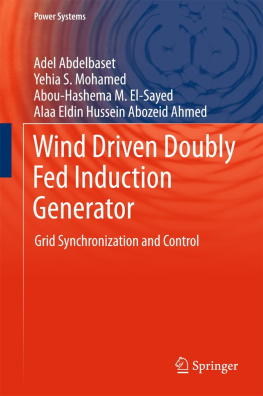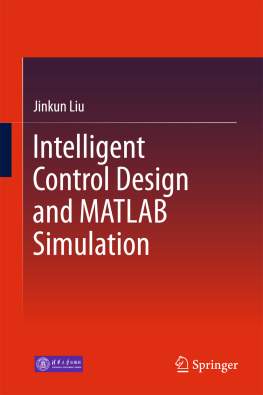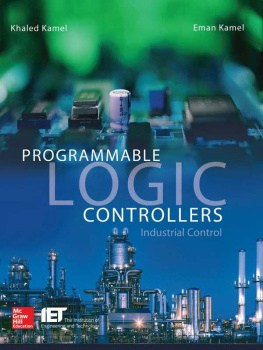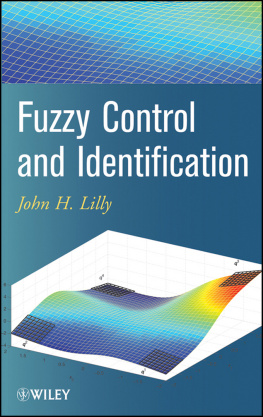Contents
Page List
Guide

Doubly Fed Induction Generators
CONTROL FOR WIND ENERGY
AUTOMATION AND CONTROL ENGINEERING
A Series of Reference Books and Textbooks
Series Editors
FRANK L. LEWIS, Ph.D.,
Fellow IEEE, Fellow IFAC
Professor
The Univeristy of Texas Research Institute
The University of Texas at Arlington
SHUZHI SAM GE, Ph.D.,
Fellow IEEE
Professor
Interactive Digital Media Institute
The National University of Singapore
PUBLISHED TITLES
Doubly Fed Induction Generators: Control for Wind Energy,Edgar N. Sanchez; Riemann Ruiz-Cruz
Optimal Networked Control Systems with MATLAB,Jagannathan Sarangapani; Hao Xu
Cooperative Control of Multi-agent Systems: A Consensus Region Approach,Zhongkui Li; Zhisheng Duan
Nonlinear Control of Dynamic Networks,Tengfei Liu; Zhong-Ping Jiang; David J. Hill
Modeling and Control for Micro/Nano Devices and Systems,Ning Xi; Mingjun Zhang; Guangyong Li
Linear Control System Analysis and Design with MATLAB, Sixth Edition,Constantine H. Houpis; Stuart N. Sheldon
Real-Time Rendering: Computer Graphics with Control Engineering,Gabriyel Wong; Jianliang Wang
Anti-Disturbance Control for Systems with Multiple Disturbances,Lei Guo; Songyin Cao
Tensor Product Model Transformation in Polytopic Model-Based Control,Pter Baranyi; Yeung Yam; Pter Vrlaki
Fundamentals in Modeling and Control of Mobile Manipulators,Zhijun Li; Shuzhi Sam Ge
Optimal and Robust Scheduling for Networked Control Systems,Stefano Longo; Tingli Su; Guido Herrmann; Phil Barber
Advances in Missile Guidance, Control, and Estimation,S.N. Balakrishna; Antonios Tsourdos; B.A. White
End to End Adaptive Congestion Control in TCP/IP Networks,Christos N. Houmkozlis; George A Rovithakis
Robot Manipulator Control: Theory and Practice,Frank L. Lewis; Darren M Dawson; Chaouki T. Abdallah
Quantitative Process Control Theory,Weidong Zhang
Classical Feedback Control: With MATLAB and Simulink, Second Edition,Boris Lurie; Paul Enright
Intelligent Diagnosis and Prognosis of Industrial Networked Systems,Chee Khiang Pang; Frank L. Lewis; Tong Heng Lee; Zhao Yang Dong
Synchronization and Control of Multiagent Systems,Dong SunSubspace Learning of Neural Networks,Jian Cheng; Zhang Yi; Jiliu Zhou
Reliable Control and Filtering of Linear Systems with Adaptive Mechanisms,Guang-Hong Yang; Dan Ye
Reinforcement Learning and Dynamic Programming Using Function Approximators,Lucian Busoniu; Robert Babuska; Bart De Schutter; Damien Ernst
Modeling and Control of Vibration in Mechanical Systems,Chunling Du; Lihua Xie
Analysis and Synthesis of Fuzzy Control Systems: A Model-Based Approach,Gang Feng
Lyapunov-Based Control of Robotic Systems,Aman Behal; Warren Dixon; Darren M. Dawson; Bin Xian
System Modeling and Control with Resource-Oriented Petri Nets,MengChu Zhou; Naiqi Wu
Sliding Mode Control in Electro-Mechanical Systems, Second Edition,Vadim Utkin; Juergen Guldner; Jingxin Shi
Autonomous Mobile Robots: Sensing, Control, Decision Making and Applications,Shuzhi Sam Ge; Frank L. Lewis
Linear Control Theory: Structure, Robustness, and Optimization,Shankar P. Bhattacharyya; Aniruddha Datta; Lee H.Keel
Optimal Control: Weakly Coupled Systems and Applications,Zoran Gajic
Deterministic Learning Theory for Identification, Recognition, and Control,Cong Wang; David J. Hill
Intelligent Systems: Modeling, Optimization, and Control,Yung C. Shin; Myo-Taeg Lim; Dobrila Skataric; Wu-Chung Su; Vojislav Kecman
Doubly Fed Induction Generators
CONTROL FOR WIND ENERGY
Edgar N. Sanchez
CINVESTAV, Unidad Guadalajara, Zapopan, Jalisco, Mexico
Riemann Ruiz-Cruz
ITESO, Tlaquepaque, Jalisco, Mexico

CRC Press
Taylor & Francis Group
6000 Broken Sound Parkway NW, Suite 300
Boca Raton, FL 33487-2742
2016 by Taylor & Francis Group, LLC
CRC Press is an imprint of Taylor & Francis Group, an Informa business
No claim to original U.S. Government works
Printed on acid-free paper
Version Date: 20160517
International Standard Book Number-13: 978-1-4987-4584-0 (Hardback)
This book contains information obtained from authentic and highly regarded sources. Reasonable efforts have been made to publish reliable data and information, but the author and publisher cannot assume responsibility for the validity of all materials or the consequences of their use. The authors and publishers have attempted to trace the copyright holders of all material reproduced in this publication and apologize to copyright holders if permission to publish in this form has not been obtained. If any copyright material has not been acknowledged please write and let us know so we may rectify in any future reprint.
Except as permitted under U.S. Copyright Law, no part of this book may be reprinted, reproduced, transmitted, or utilized in any form by any electronic, mechanical, or other means, now known or hereafter invented, including photocopying, microfilming, and recording, or in any information storage or retrieval system, without written permission from the publishers.
For permission to photocopy or use material electronically from this work, please access www.copyright.com (http://www.copyright.com/) or contact the Copyright Clearance Center, Inc. (CCC), 222 Rosewood Drive, Danvers, MA 01923, 978-750-8400. CCC is a not-for-profit organization that provides licenses and registration for a variety of users. For organizations that have been granted a photocopy license by the CCC, a separate system of payment has been arranged.
Trademark Notice: Product or corporate names may be trademarks or registered trademarks, and are used only for identification and explanation without intent to infringe.
Visit the Taylor & Francis Web site at
http://www.taylorandfrancis.com
and the CRC Press Web site at
http://www.crcpress.com
Dedication
To my wife Maria de Lourdes, and our children, Zulia Mayari, Ana Maria, and Edgar Camilo
Edgar N. Sanchez
To my parents Abel and Romelia, and my brothers Urania, Neretva, and Euclides for their provided support
To Marina Flores for all her love and patience during the writing of this book
Riemann Ruiz-Cruz
Contents
Due to the vast increase in renewable energy, research on this topic is very important. In particular, the use of wind energy has spread quickly across the planet, and has proved to be very profitable. Furthermore, caused by the unpredictable wind nature, wind energy presents many challenges, such as fluctuations in the generated power due to wind variations, complications to achieve efficient coupling to the grid, and limitations produced by mechanical generator oscillations, among others. These problems have led to the development of controllers, which are able to handle such situations. The purpose of this book is to provide a detailed source of information on modeling and design of nonlinear controllers for the doubly fed induction generator (DFIG), as used in wind energy applications.

